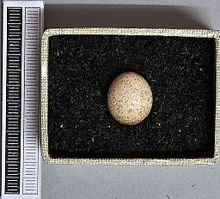Reed Warbler
| Reed Warbler | ||||||||||||
|---|---|---|---|---|---|---|---|---|---|---|---|---|

Reed Warbler ( Acrocephalus schoenobaenus ) |
||||||||||||
| Systematics | ||||||||||||
|
||||||||||||
| Scientific name | ||||||||||||
| Acrocephalus schoenobaenus | ||||||||||||
| ( Linnaeus , 1758) |
The reed warbler ( Acrocephalus schoenobaenus ) is a songbird belonging to the genus of the reed warbler ( Acrocephalus ) and the reed warbler family (Acrocephalidae). No subspecies are distinguished.
distribution
Apart from the southwest of Central Europe, the reed warbler is a common breeding and summer bird in large parts of Central Europe. In all of Central Europe, however, it occurs as a migrant and resting bird.
description
The reed warbler is about 13 cm long and has a wingspan of 17 to 21 cm. The weight is about 10 to 15 grams. The top is patterned brown-gray, its underside is yellowish in color. The little bird has a whitish throat and a pointed beak. He has a light gray eye stripe and a black head cover. Males and females have the same coloration. His call sounds like "tscheck" and "schrrr".
habitat
The reed warbler occurs as a breeding bird from the boreal to the Mediterranean and steppe zone of the western and central Palearctic. Its height distribution extends from the lowlands to the lower mountain ranges. In north-western Europe the distribution is patchy, the southern limit of distribution is in the north of the Mediterranean and the Danube delta of Romania. There are partially fragmented occurrences in the southwest, the center and the east of Anatolia. The species is also found in the Crimea, Azerbaijan and northwestern Iran.
In almost all of Europe is long-distance migrant from April to October in attendance. He has his winter quarters south of the Sahara in Africa . Departure time and direction of movement are innate to him. In order to survive the 6,000 kilometers well, the night puller builds up fat reserves. The reed warbler lives in dense reeds and riverside bushes, in moors, swamps, on wet meadows and in cultivated land.
nutrition
The reed warbler feeds on insects , arachnids , smaller mollusks and berries .
Reproduction
Sexual maturity occurs after a year. The main breeding season is May to July. The nest is built low above the ground in thick vegetation. The female lays 4 to 6 eggs . The eggs are warmed alternately by both partners for 12 to 14 days. The young birds fledge after 10 to 12 days.
Duration
The total European population is estimated at 4.4 to 7.4 million breeding pairs. Large populations are found in Russia, where there are between 1.3 and 2.5 million breeding pairs, Romania (0.85 to 1.1 million breeding pairs) and Bulgaria (0.6 to 0.8 million breeding pairs). The population in Central Europe is estimated at 315,000 to 593,000 breeding pairs.
literature
- Hans-Günther Bauer, Einhard Bezzel and Wolfgang Fiedler (eds.): The compendium of birds in Central Europe: Everything about biology, endangerment and protection. Volume 2: Passeriformes - passerine birds. Aula-Verlag Wiebelsheim, Wiesbaden 2005, ISBN 3-89104-648-0 .
Web links
- Profile of the reed warbler of the Swiss bird observatory
- Singing reed warbler at www.vogelstimmen-wehr.de
- Acrocephalus schoenobaenus in the endangered Red List species the IUCN 2008. Posted by: BirdLife International, 2008. Accessed January 31 of 2009.
- Videos, photos and sound recordings of Acrocephalus schoenobaenus in the Internet Bird Collection
- Age and gender characteristics (PDF; 1.4 MB) by Javier Blasco-Zumeta and Gerd-Michael Heinze (English)
- Reed warbler feathers
Individual evidence
- ↑ Bauer et al., P. 223

